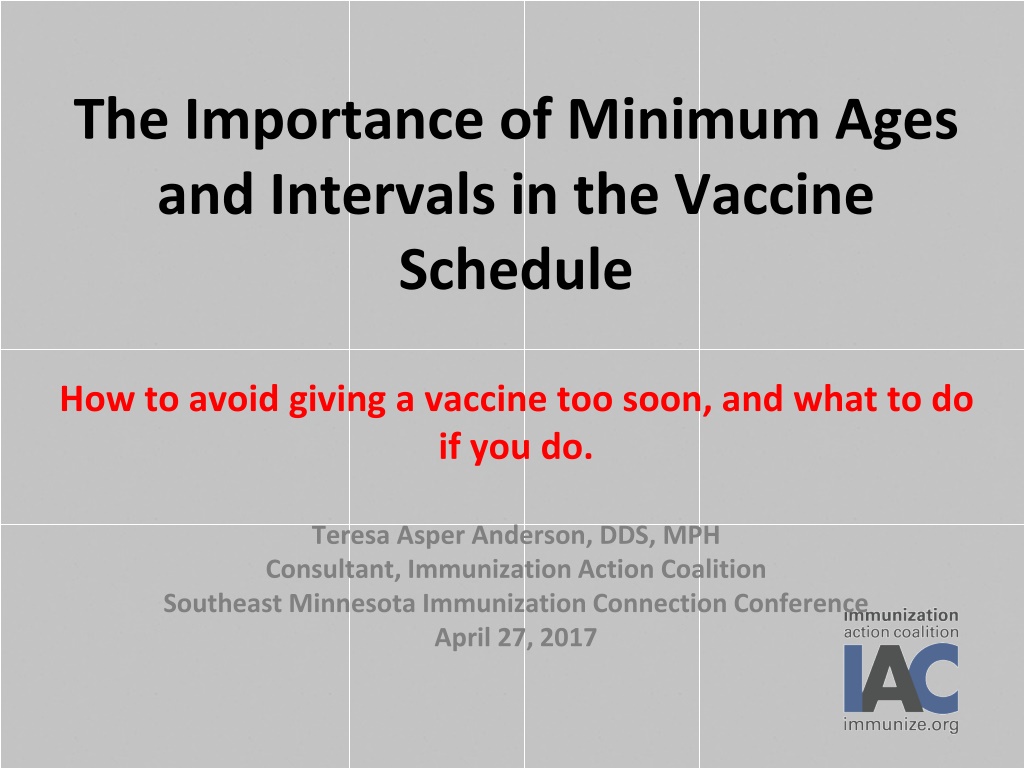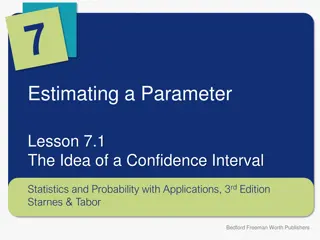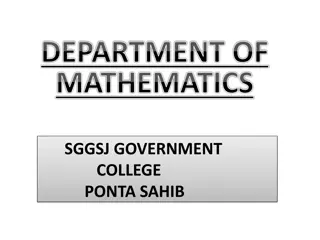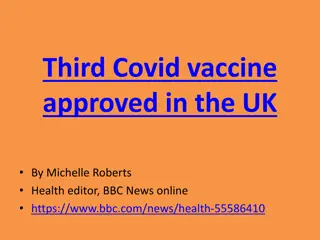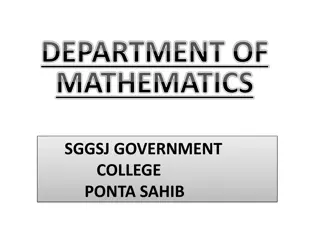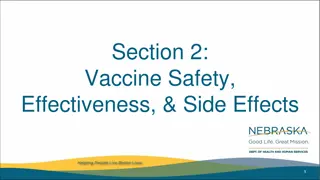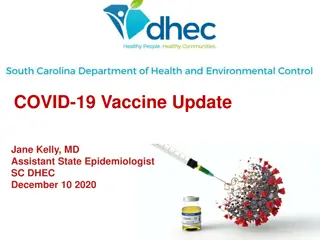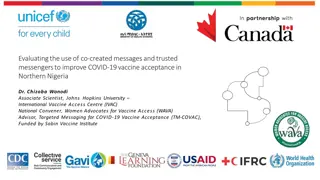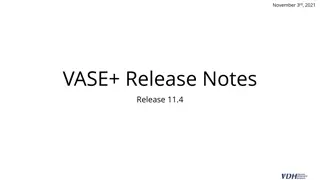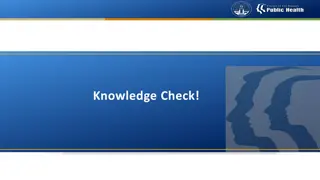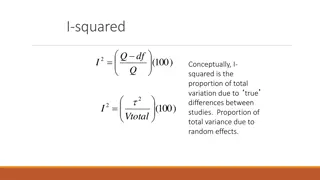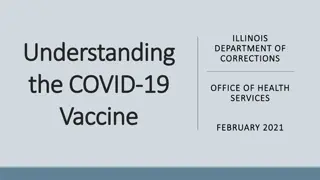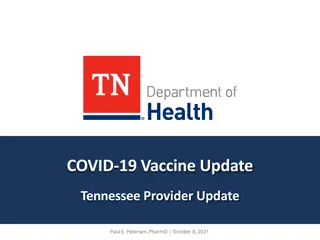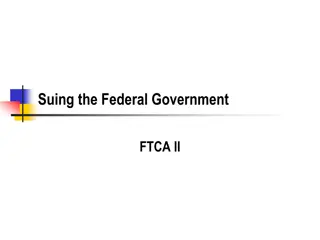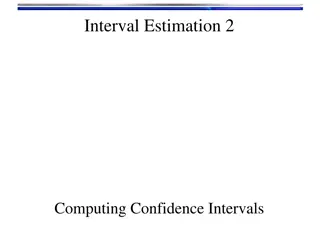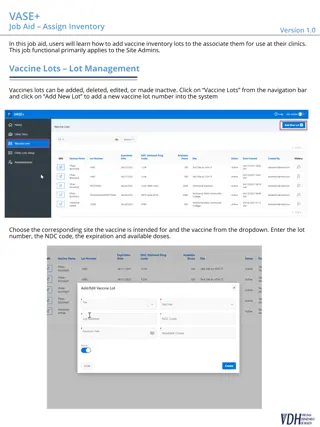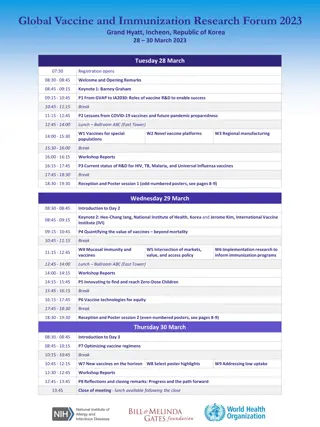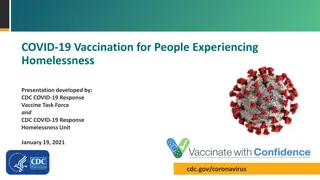Importance of Vaccine Minimum Ages & Intervals
Addressing scheduling errors in vaccine administration is crucial. Learn about vaccine minimum ages, intervals, and how to prevent errors in vaccination timing to ensure optimal protection. Explore insights from experts and data on common errors for a better understanding of the significance of adhering to recommended schedules.
Download Presentation

Please find below an Image/Link to download the presentation.
The content on the website is provided AS IS for your information and personal use only. It may not be sold, licensed, or shared on other websites without obtaining consent from the author.If you encounter any issues during the download, it is possible that the publisher has removed the file from their server.
You are allowed to download the files provided on this website for personal or commercial use, subject to the condition that they are used lawfully. All files are the property of their respective owners.
The content on the website is provided AS IS for your information and personal use only. It may not be sold, licensed, or shared on other websites without obtaining consent from the author.
E N D
Presentation Transcript
The Importance of Minimum Ages and Intervals in the Vaccine Schedule How to avoid giving a vaccine too soon, and what to do if you do. Teresa Asper Anderson, DDS, MPH Consultant, Immunization Action Coalition Southeast Minnesota Immunization Connection Conference April 27, 2017
Background Healthcare professionals and members of the public can contact IAC by writing to admin@immunize.org. I answer ~200 300 such emails each month, with help from other IAC staff and consultants. I also refer people to the CDC experts at nipinfo@cdc.gov. It appears that more errors are being made (IZ schedule more complex, additional available products, alternative schedules, more recommended adult vaccines). In addition, some types of errors that might have gone undetected in the past are now caught by state immunization information systems.
From January 2015 through December 2016, IAC received questions about approximately 770 medical errors related to vaccination, including errors in vaccine storage and handling, administration, scheduling, and documentation.
Scheduling errors, including violations of the minimum age and interval rules, giving vaccines simultaneously when not recommended, and administering 2 live virus vaccines not given together less than 4 weeks apart, were the #1 type of error reported to IAC over this 2-year period 33% of the total.
Types of Vaccine Administration Errors Communicated to IAC January 2015 December 2016 160 144 140 120 110 100 96 100 80 72 69 60 41 36 35 40 20 18 15 20 7 5 0
A CDC study using VAERS data from 2000 13 also found that the most common error group was inappropriate schedule 5,947 (27%) of the total identified 21,843 errors. Vaccination Errors reported to the Vaccine Adverse Event Reporting System, (VAERS) United States, 2000 2013; Vaccine, June 22, 2015 https://www.ncbi.nlm.nih.gov/pubmed/25980429
What exactly are vaccine minimum ages and intervals?
Minimum ages and intervals for vaccines Minimum age: the youngest age group at risk for a disease for whom efficacy and safety of a vaccine have been demonstrated. Minimum interval: the shortest allowed interval between doses of a series, based on the results of clinical trials for efficacy and safety. Vaccine doses should not be administered at intervals less than the minimum intervals or earlier than the minimum age.* Conversely, increasing the interval between doses of a multi- dose vaccine does not diminish the effectiveness of the vaccine. * One exception: ACIP recommends a dose of MMR for infants age 6 11 mos who will be traveling internationally or who are at risk due to a measles outbreak. This dose does not count as dose #1, however.
IMPORTANT RULE: Vaccine doses should not be administered at intervals less than the recommended minimal intervals or earlier than the minimal ages. But there is no maximum interval! (except for oral typhoid vaccine in some circumstances)
Doses given even years later than recommended are still valid because the body has immunologic memory. The real problem with longer than recommended intervals is not the validity of the doses or their immunologic effect. It is that, until the series is complete, the person may remain susceptible to the associated vaccine- preventable disease.
What else does ACIP have to say about the use of minimum ages and intervals?
From ACIPs General Recommendations on Immunization Vaccination providers should adhere as closely as possible to the recommended vaccination schedules to provide optimal protection. Administration of doses of a vaccine series using intervals that are shorter than recommended might be necessary in certain circumstances, such as impending international travel or when a person is behind schedule but needs rapid protection. You also might choose to seize the opportunity and give vaccines at the minimum intervals when a patient who is in the office is unlikely to return for recommended visits.
From ACIPs General Recommendations on Immunization continued The accelerated schedule should be used when a child is more than a month behind schedule. Once you have the child back on schedule, use the recommended ages and intervals on the childhood schedule. Vaccine doses should not be administered at intervals less than these minimum intervals or at an age that is younger than the minimum age. Doses administered too close together or at too young an age can lead to a suboptimal immune response and will be considered invalid.
From ACIPs General Recommendations on Immunization continued Administering a dose a few days earlier than the minimum interval or age is unlikely to have a substantially negative effect on the immune response to that dose. Therefore, ACIP allows a 4-day grace period for vaccine doses administered before the minimum interval or age.
ACIPs Grace Period Vaccine doses administered up to 4 days before the minimum interval or age can be counted as valid. The grace period should be used primarily when reviewing vaccination records. The 4-day grace period should not be used when scheduling future vaccination visits, and cannot be applied to the 28- day interval between two different live parenteral vaccines not administered at the same visit. The grace period cannot be used for rabies vaccine. Local or state mandates might supersede this 4-day exemption.
How to count ages and intervals If the interval is less than 4 months, it is common to convert months into days or weeks (e.g., 1 month = 4 weeks = 28 days). For intervals of 4 months or longer, you should consider a month a "calendar month": the interval from one calendar date to the next a month later (e.g., 6 months from October 1 is April 1). This is a convention that was introduced on the childhood schedule in 2002. Check the exact wording on CDC s IZ schedules.
What happens when you violate a minimum age or minimum interval rule?
The result of making such errors can be serious, including harm to the vaccinee from a side effect or vulnerability to disease, inconvenience to the parent or patient with ill will and loss of trust in the provider and possible negative publicity or even legal action, and/or unreimbursed cost to the provider. Avoiding such errors benefits everyone.
HELP! I am a nurse consultant on-call for the state of X. I just received a call from a nurse who tells me she just gave a set of 1-year shots to a 9-month-old all 6 immunizations.
HELP! I have a patient who got his 1st hep A vaccine on 1/30/14 and his 2nd on 6/13/14. According to our state registry, it is not valid. I am wondering if we have to repeat the 2nd dose or if there is any leeway. The patient is about to enter preschool.
HELP! We have a new patient, a 17-year-old female, who, according to her records, received the MCV4 vaccine three times, at ages 11, 12, and 13. Does she still need a booster at 16?
HELP! While registering her for kindergarten, it was brought to my attention by the school RN that my daughter's initial MMR vaccine may not be valid. She received this dose 25 days before her first birthday. I do not want to re-administer a 3rd vaccine if it is not necessary. What, if any, steps can I take to avoid re-vaccinating my daughter?
HELP! A nurse in my office accidentally gave flu vaccine to 3-month-old twins. Mom is understandably very upset. Is there any data on the safety or efficacy of this vaccine in babies under 6 months?
Common minimum age errors Giving the 1st dose of MMR, varicella, or hepatitis A vaccine before age 12 months. Giving the second dose of MCV4 vaccine before age 16 years. Giving the 4th dose of DTaP before age 12 months (or less than 6 months after 3rd dose). Finishing infant s hepB series before age 24 wks. Giving any vaccine (except hepatitis B) before age 6 weeks.
Common minimum interval errors Giving 2nd dose of hepatitis A vaccine less than 6 months after the first dose. Giving the hepatitis B vaccine series without at least 4 wks between doses 1 and 2; 8 wks between doses 2 and 3; and 16 wks between doses 1 and 3. Giving the HPV vaccine series without at least 4 wks between doses 1 and 2; 12 wks between doses 2 and 3; and 24 wks between doses 1 and 3. Not allowing 6 months between the next-to-last and last dose of IPV.
How to avoid such errors? Keep an easy-to-read immunization schedule handy for clinical staff. Plan to follow the RECOMMENDED schedule. Know the minimum intervals for all vaccine series. Train front-office staff to never schedule well-child visits before the critical dates (e.g., make sure child will actually be 12 months old at 1-year checkup ). Attempt to locate old vaccination records by contacting previous healthcare providers and reviewing your state registry. If you still aren't sure if a dose will be valid, check with your state immunization program before giving it.
A clinicians best friend CDC s Recommended and Minimum Ages and Intervals Between Doses of Routinely Recommended Vaccines www.cdc.gov/vaccines/pubs/pinkbook/downloads/appendices/A/ age-interval-table.pdf
And/or check with your state immunization registry about when the next dose should be given!
Addition hints on avoiding scheduling errors Provide parents/caregivers, teens, and adults with easy-to-read immunization schedules so they know what vaccine(s) they or their child should be receiving during visits to a healthcare provider. If a child or teen misses a particular vaccination(s), create an individualized catch-up immunization schedule and provide it to the parent or caregiver. Use standard orders: www.immunize.org/standing-orders. Using standing orders will also help you avoid other types of errors, as they include age indications, contraindications, route, needle gauge and length, injection site, etc.
But stuff happens! What should you do if you inadvertently give a dose at an earlier age or interval than allowed?
Minimum interval violations A dose administered 5 or more days earlier than the recommended minimum interval between doses is not valid and must be repeated. The repeat dose should be spaced after the INVALID dose by the recommended minimum interval.
Real-life example: The minimum interval between the 2 doses of hepatitis A vaccine is 6 months. A child received the 2nd dose of hepatitis A vaccine on March 13, 2017, only 5 months after the 1st dose. The earliest this child should receive a make-up dose would be 6 months after the invalid dose of March 13 (i.e., on or after September 13), NOT 6 months after the first dose (April 13). You can t just ignore an invalid dose! Unfortunately, this is a little understood rule, so children end up receiving multiple invalid doses.
Minimum age violations Doses administered 5 or more days before the minimum age should be repeated on or after the patient reaches the minimum age. If the vaccine is a live virus vaccine, waiting at least 28 days from the invalid dose is recommended. ACIP does not require a minimum interval when an inactivated vaccine is given before the minimum age. Once the minimum age is reached, the repeat dose can be given and can be counted. (This is the MIIC protocol.) If the vaccine is a live virus vaccine, ensuring that a minimum interval of 28 days has elapsed from the invalid dose is recommended. HOWEVER, some state immunization registries follow a stricter rule, and, when a dose is given before the minimum age, require that the next dose be given after both the minimum age and interval.
CDC allows some other exemptions for minimum age/intervals violations, in addition to the 4-day grace period. Some of these are not published other than on their website or in personal correspondence. The Minnesota Immunization Information Connection s (MIIC) goal is to follow published ACIP recommendations.
ACIP-allowed minimum age/interval exemptions that are valid in MIIC (besides the 4-day grace period) If a child younger than 13 years receives varicella #2 at an interval of 4 weeks or longer (instead of 3 months) from varicella #1, the dose does not need to be repeated. If DTaP #4 is given with at least a 4-month interval (instead of 6 months) after DTaP #3, it does not need to be repeated. The minimum age of 12 months for the 4th dose must be met. The 3rd dose of HPV can be considered to be valid if it was separated from the first dose by at least 16 weeks (instead of 24) and from the second dose by at least 12 weeks.
To report errors The Institute for Safe Medication Practices (ISMP) has a website to report vaccine errors the Vaccine Error Reporting Program (VERP). VERP was created to allow healthcare professionals and patients to report vaccine errors confidentially. By collecting and quantifying information about these errors, ISMP will be better able to advocate for changes in vaccine names, labeling, or other appropriate modifications that could reduce the likelihood of vaccine errors in the future. http://verp.ismp.org ISMP sends all reports submitted to VERP to the Vaccine Adverse Event Reporting System (VAERS).
In March 2015, ISMP published an excellent guide titled Recommendations For Practitioners To Prevent Vaccine Errors www.ismp.org/newsletters/acutecare/showarticle.aspx?id=104
To report errors continued CDC recommends that healthcare professionals also report vaccine errors to the Vaccine Adverse Events Reporting System (VAERS). If an adverse event occurs following a vaccine administration error, a report should definitely be sent to VAERS. Adverse events should be reported to VAERS regardless of whether a healthcare professional thinks it s related to the vaccine or not, as long as it follows administering a dose of vaccine. https://vaers.hhs.gov/index
Other scheduling errors This presentation has focused on minimum ages and intervals between doses of the same vaccine. Of course, there are other types of scheduling errors. Giving vaccines simultaneously when not recommended. Administering 2 live virus vaccines not given together less than 4 weeks apart.
Giving vaccines simultaneously Almost all vaccines used in the United States may be given simultaneously. ACIP and AAP consistently recommend administration of all indicated vaccines. There is no evidence that simultaneous administration of vaccines either reduces vaccine effectiveness or increases the risk of adverse events. Avoid missed opportunities! Simultaneous administration of all vaccines for which a child is eligible is very important because it increases the probability that a child will be fully immunized at the appropriate age. A study during a measles outbreak in the early 1990s showed that about 1/3 of measles cases in unvaccinated but vaccine-eligible preschool children could have been prevented if MMR had been administered at the same visit when another vaccine was given.
Giving vaccines simultaneously Here are the general rules: 1) Almost all vaccines used in the United States may be given simultaneously (at the same visit, not in the same syringe). 2) An inactivated vaccine can be administered either simultaneously or at any time before or after a different inactivated or live vaccine.
Giving vaccines simultaneously 3) All live vaccines (MMR, varicella, zoster, live attenuated influenza, yellow fever, and oral typhoid) can be given at the same visit. Any two LIVE injectable or nasally administered virus vaccines not given at the same time must be given at least four weeks apart. ORAL live vaccines (Ty21a typhoid vaccine, cholera, and rotavirus) can be administered simultaneously or at any interval before or after other live vaccines (injectable or intranasal) if indicated.
Giving vaccines simultaneously There are 3 exceptions to these general rules, and 2 of them apply only to the use of Menactra with people with certain high-risk health conditions, such as asplenia or complement component deficiency. The only commonly encountered exception is the recommendation to not give PCV13 and PPSV23 at the same time.
PPSV/PCV scheduling recs For adults age 19 64 who are receiving both vaccines due to a high-risk condition, PCV13 should be given first followed by PPSV23 at least 8 weeks later. If PPSV23 has already been given, wait 8 weeks (for a child) or 1 year (for an adult age 19 years or older) before giving PCV13 to avoid interference between the 2 vaccines. For adults age 65 and older who are receiving both PCV13 and PPSV23 as part of the routine recommendation, PCV13 should be given first and PPSV23 a year later. If PPSV23 has already been given, wait 1 year to give PCV13.
Resources for PCV/PPSV recommendations Pneumococcal Vaccine Timing http://eziz.org/assets/docs/IMM-1152.pdf Pneumococcal Vaccine Timing For Children http://eziz.org/assets/docs/IMM-1159.pdf Adult Pneumococcal Vaccination Guide for HCPs www.adultvaccination.org/professional- resources/pneumo/adult-pneumo-guide-hcp.pdf Pneumococcal Vaccination Recommendations for Children and Adults by Age and/or Risk Factor www.immunize.org/catg.d/p2019.pdf
